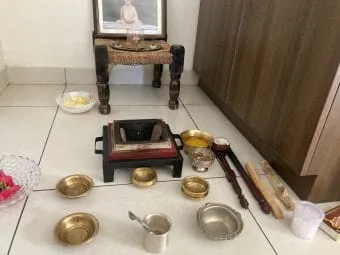Jai Sri Hari!! An extra big and cozy hug to my dearest OS.me family. I have been missing in action for some time. It’s nine at night, and I am writing in my balcony listening to insects chirp away. The full moon is covered by a translucent cloud and is shyly peeping from behind it, reminding you how magical and sensual the Poornima night can be.
I completed my 30-Day Guru Sadhana with you and wanted to share my story with all of you. I am doing this knowing that Swamiji has generally forbidden Sadhaks to share details of their Sadhana. He says that “the scriptures are very clear about it, that one must never disclose their Sadhana unless it is with their Guru. The impact goes down significantly if you do this. The moment you share it with someone, they will ask you about your experience. Even if that is OK, the trouble comes when you exaggerate those experiences and begin telling yourself a story that you start to believe. You will then start to defend those experiences, and that involves a lot of lies. When you lie on this path, that significantly weakens your consciousness as a Sadhak. Let your success speak for itself, let people feel your energy, and deduce if you are doing some sadhana.”
If he is so explicit in his instructions, why am I discussing my Sadhana with you? Let me start by saying I love Swamiji more than anything else in this world. I would happily jump into the fire if he asked me to. In this case, I am choosing to talk about my Sadhana because I remember him talking about purity of intent in one of his talks. The purity of intention surpasses anything else associated with the action. So what is my intention for this post?
Intention for This Post
The intention of this article is to simply convince other sadhaks, especially grihastas, that with a bit of dedication and commitment, we can all complete a purushcharna for mantra sadhana. I have spent a couple of years sitting on the fence after meeting Swamiji because I found him intimidating. His discipline, focus, and clarity of thought make him a fantastic guru but almost impossible to model. How do you aspire towards perfection when you are so flawed yourself. He was a monk, and I was fully immersed in family life. How could I even aspire to the same goals? By completing this thirty-day Sadhana, I have taken one more step in my journey. The only intention of this article is to convince you that if I can do it, anyone can do it. I am sharing this Sadhana because all the information I am sharing is already given in the Mantra handbook. I simply want to emphasize that while it seems intimidating, it becomes second nature once you start practicing the Sadhana. I will not share any Sadhana I receive from Swamiji after I become initiated since that would violate the guru shishya parampara.
The Reason for Doing Guru Sadhana
In his video, Art of Mindfulness for a Householder, Swamiji talked about how the Purushcharana gives every householder cold feet. IT PIERCED MY HEART because I felt he was talking to me. The 36 steps, the mudras, the preparation for the havan, the variety of offerings, the time commitment all seemed too much for a mere householder to accomplish.
A voice within me kept insisting that I should begin during Guru Purnima, so I chose July 23rd as the first day of my Sadhana. I spoke to my wife, son, and parents because they would all have to make sacrifices due to the various restrictions that were a part of this Sadhana.
Preparing for the Sadhana
I don’t like detailed planning. I prefer to do my homework, work out a tentative plan, and learn from day-to-day experience. I followed the same path for this Sadhana. It really helped me because I was not intimidated by the various instructions and cross-references included in the book. I was sure that I would make many mistakes, but that was the nature of my relationship with the divine. I generally dive in with pure intentions and trust that the divine would guide me whenever needed. However, given my experience, here are few things you can do to prepare for the Sadhana:
- Read the Essential Steps in Rites of Invocation chapter multiple times. That’s the most crucial chapter for doing any Sadhana in the book.
- Read the chapter on your Sadhana multiple times just to understand the flow of steps. You will find many references to the Essential Steps in Rites of Invocation, so reading that first would help you.
- Read the Arrangement of Pots chapter to understand how you set up for the Sadhana.
- Read the Types of Offering chapter to see various offerings you can make. I did only five offerings: scented water, flowers, incense, lamp, and fruit for naivaidyam.
- Read the chapter on how to make fire offerings. I got a havan kund from my parents, bought a few kgs wood, cow dung cake, and camphor for the fire. Ghee and a mixture of havan samagri, white tile, black til, dry fruits, and rice became the offering for the havan. You also need a dry coconut for purnahuti.
- Take a mental oath of 30-day abstinence and avoidance of any food with onion and garlic.
- Practice sitting on the ground for 30-45 minutes every day because you need roughly two hours to complete your Sadhana.
Taking Permission from the Divine Mother
The Sadhana requires us to do 30 rounds of Gayatri mantra chanting one night before commencing the Sadhana. I took a bath, wore white clothes, and did 30 rounds of Gayatri chanting on July 23rd.
Setting Up for the Sadhana

We need to ensure that we face the north or northeast while doing the Sadhana. Since my Pooja Room is east-facing, I modified my setup for the Sadhana. The following image shows everything I used during the Sadhana. Please refer to Swamiji’s book for exact details. My image is simply to illustrate my daily setup.
The first level was Swamiji’s picture, with a lamp, a rose, and a fruit. The next level was my havan kund with three cow dung cakes and camphor within it. Next to the havan kund is a ghee vessel, a vessel with the samagri mix, a camphor box, and two spoons to offer ghee and dry coconut for purnahuti.
The third level is all the pots described in the Arrangement of Pots chapter. Finally, I have my seat with a small cushion. It takes roughly 15 minutes to set up for the Sadhana every day. You need to remove the previous day’s offerings from the Havan Kund, clean it, and arrange everything for a new day.
The Pre-Chanting Phase
The first twenty-four steps took me thirty minutes during the first week and fifteen minutes during the last three weeks since I got used to it. I am excluding bathing time, obviously. While the mudras, kara shudhi, and Nyasa look particularly intimidating, doing it for a couple of days makes you very comfortable with the whole process. You literally breeze through it after the first week. The illustrations in the book do an excellent job of explaining each action, so you don’t have to worry about going wrong.
A few things to remember during this phase are:
- It’s straightforward and enjoyable after the first few days. Don’t get intimidated by the number of steps.
- Step 16 – Sankalpa is done during the first day. Don’t do it every day.
- Step 22 – Handlocks is covered in the Handlocks chapter. However, please check page 174 before doing the mudras. You need to do a few steps before beginning the mudras.
The Actual Chanting Phase
We have to do 40 malas of the Guru mantra shared in the book, and I used the “counter-app” mobile application to count the total number of malas. The chanting took 60-75 minutes, depending on how I was feeling on a specific day. I varied between mentally changing and silently chanting the mantra. Here are a few things that I learned during this phase:
- You are already 20-30 minutes into the Sadhana, so your legs may start aching. I initially sat on a sofa and chanted, but it did not feel right, so I started standing and chanting. However, over the next couple of weeks, the ability to sit on the ground improved dramatically. By the end of the Sadhana, I could comfortably sit for a couple of hours. I would raise either leg for a couple of minutes and put it down again.
- Your concentration is directly proportional to how straight your spine is during the chanting process. Maytimes, I would realize I have drifted off during the Sadhana and would straighten my back to gather my concentration.
- It’s OK to not be perfect because the mind would drift. I tried my best and was very happy with the results.
- You can vary the pace of chanting to make it more mindful and interesting.
- Your mind very quickly adjusts to the fact that you need to do 40 rounds of chanting. I was seriously concerned because I have never done such an extensive Sadhana, but his grace meant it happened effortlessly.
The Havan
After completing the chanting, you have steps that take 3-4 minutes before starting the Havan. I absolutely loved doing the havan and physically miss the process since my Sadhana has culminated. You need a good havan kund, wood, havan samagri, ghee, black and white til, rice, lots of camphor, dry fruit mix, two wooden spoons, and dry coconut for the purnahuti.

You can mix the samagri, rice, tils, and dry fruits to create the samagri mix.
I also used cow dung cakes because we traditionally used them for Gayatri Havan as kids. I would arrange three cakes in the havan kund and add liberal amounts of camphor to them. Then I lit the camphor and added one-two pieces of wood since it was a small havan kund. I would then begin the havan mantras, and since the first set of mantras involve ghee, the fire would catch on really well. When you chant mantras and offer ghee/samagri mix, you can see the Agni accepting your offering and leaping up to greet you. The process is hypnotic, powerful, and you feel there is a havan going on inside you, while one happens outside you. I also felt this is the most sensitive part of the Sadhana. My general lack of concentration felt acceptable during the chanting, but I repeatedly saw that the Agni would not rise till I started chanting mindfully. My mind often wandered to the description of Prajapati’s havan, which had thousands of brahmins doing this Pooja and how the fires almost reached the sky. I also saw myself doing havan sitting on the ashram terrace while facing the mountains.
Some key things I learned while doing the havan are:
- You need to manage the fire properly. Use a combination of ghee and camphor to manage the levels of Agni.
- I was always nervous about the fire dying out, so I would try to rush through the chants. We need to do 400 chants of the mantra here. The fire invariably lasted almost 30 minutes after I completed the Sadhana, but that fear always drove me to rush through the chanting.
- If you are burning wood sticking out of the havan kund, you need to be careful. The fire will inevitably burn hottest in the middle, and the wood will break into two pieces. There are high chances of a burning piece falling outside the havan kund. Use the wooden spoon used to offer ghee to break the stick when it’s about to crack.
- Enjoy the havan. Doing it properly offers a gateway to ancient times, and you feel amazingly energized after completing it.
Some Interesting Experiences During Sadhana
These are my personal experiences and I have done my best to be honest about sharing them. Every Sadhak has their own experiences and it’s never wise to compare or exaggerate your experience.
- When you chant the Sankalpa in Step 16, it literally forms a kavacha around you. Unless you set out to break your resolution, things happen to make it work for you. Since we had a thirty-day abstinence period, I was sure I could control my thoughts during the day, but what happens when we go to sleep. For someone not used to abstinence, dreams are when the subconscious comes out swinging for the fences. I typically don’t remember my dreams, but for multiple nights, I remember being conscious during my sleep and chanting the guru mantra the moment a racy dream made an appearance. I would literally wake up chanting and with a smile on my face before going back to sleep.
- My work and schedule automatically seemed to arrange themselves to suit my Sadhana. I had the energy to complete the Sadhana, cook breakfast for my family, finish my work, and help with the dishes.
- My body adjusted to sitting on the ground for a couple of hours really quickly. I expected a lot more pain and aches, but they never manifested.
- On the final day of the Sadhana, I felt something snap within me after I completed it. It felt like I was unbuttoning a jacket. A few minutes later, I felt I was almost back to how I was a month ago. Something small has shifted, but the protection I had for those days had now expired. Now it was back to good old willpower and the trial-error method.
- There was a throbbing feeling on the center of my forehead whenever I concentrated on it for a few days. It was far more powerful than any other sensation I have ever felt.
- I ended with confidence that I could do this for the rest of my life if I chose to do it. However, the moment the protection snapped, I realized how much work I needed to put into myself to get ready for bigger sadhanas.
Some Key Lessons I Learnt
Here are some key lessons I learned after completing the Sadhana. These are just my thoughts, and you can choose to completely disregard them if you disagree.
- It’s a crime to relegate Swamiji to your Pooja room and not do any Sadhana – We are a religious country and are very comfortable in our relationship with God. We pray to them, talk to them, and they are a significant part of our life. I simply added Swamiji to the collection of gods in my Pooja room and prayed to him too. This mantra sadhana made me realize the power of a living guru. The greatest lesson to learn is that OM SWAMI is a POSSIBILITY. We have someone who achieved enlightenment in our lifetime and is willing to show us the way. If we don’t use this opportunity, then what hope do we have?
- The only purpose of Sadhana is to prepare yourself to do more Sadhana. I did not have any goal or outcome for this Sadhana. I realized that my current level is only 10%, and I need a lifetime’s worth of practice to actually be worthy of offering anything to the divine. That’s such an empowering thought because the joy of Sadhana is in doing it. Any other experience you have is temporary and, to a large extent, inconsequential.
- The divine forgives anything as long as the intent is pure. I have mispronounced mantras, arranged pots wrongly, missed out on ingredients in the havan for the initial days. I kept having a gentle voice that would sometimes tell me to stop on a page and reread it, and I gradually got better. I even began my Sadhana on the wrong day. It was supposed to be started on a new moon day, but I felt strongly that I should start it during Guru Purnima, so I just did it. I did not even realize my mistake till my dear friend Amrendra pointed it out.
- Your family plays an immense role in the success of your Sadhana. My wife and son supported the whole process. My mother prepared ghee every few days for the havan and prepared nourishing satvik meals. It is challenging for a grihastha to complete Sadhana without your family’s support.
I want to end this marathon post by telling you that this Sadhana is only challenging if you don’t begin it. The moment you start it, something grabs hold of you and takes you through the whole process lovingly, joyfully, and peacefully. I have severe withdrawal syndrome now that I have completed it. The old tendencies are rushing back, but I am aware of their existence. I miss chanting and havan so much that I have to find a way of including them in my day-to-day routine.
Thank you, dear Parivar, for getting through to the end of this post. Remember, Om Swami is a possibility. Please see if you can launch the process of realizing that in your lives.
A big shout out to Meera Di for being a pillar of support during this Sadhana. Also, a thundering round of applause to my wife Rashmi Sharma, for her immense support during the past month.









Comments & Discussion
76 COMMENTS
Please login to read members' comments and participate in the discussion.